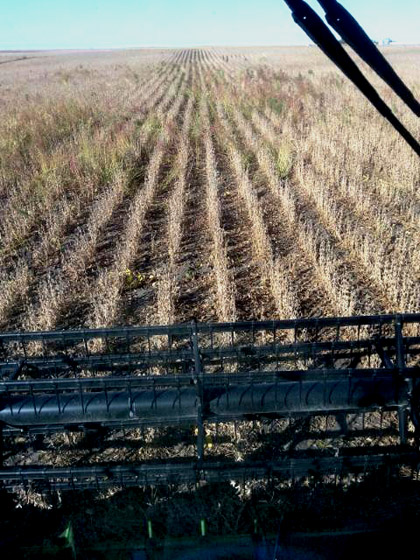Source: Iowa Soybean Association
You’re going to see a lot of soybean and corn plants go by as you’re looking out the combine windshield over the next few weeks.
Rather than just staring through the glass, though, you could be making use of the technology wrapped up in your yield monitor to mark field locations you might like to go back to later.
 |
| Use your yield monitor and GPS to mark patches of uncontrolled weeds and other field problems observed during harvest. |
“Recording the location of problem areas is a good use of the GPS marking feature in combine yield monitors,” says Pat Reeg, ISA On-Farm Network operations manager. “These geo-referenced marks and notes are beneficial after harvest when analyzing yield maps and aerial imagery and may be helpful in turning data into decisions.”
What to look for:
Weeds. Look for escapes, especially in patches, or single weeds where weed control seems good otherwise. This may be a sign of herbicide resistance. This should help with herbicide decisions for 2014. If you’re in southwest Iowa, or near the Mississippi River, you should keep an eye out for Palmer Amaranth, a problem weed from the south which now has been found on both sides of the state.
Stand. Mark areas where plant populations are and why, identifying whether it’s in a wetter- or dryer-than-normal area of the field.
Bare spots. Could be due to herbicide application problems, excessive moisture, planter problems, etc.
Plant height. Look for spots where plants seem either shorter or taller than the rest of the field, or surrounding area. Differences might be due to variations in soil type, moisture availability (too much or too little) or other reasons. If it's enough to concern you, make notes.
Lodging. Most likely reason would be wind combined with poor root development. Reasons for poor root development could be weather related, or, in corn, from corn rootworm damage. If yields are significantly lower in lodged areas, you might need this information for yield loss claims on crop insurance. Does lodging appear to be related to changes in variety of hybrid in the field? Such information could be helpful in future seed selection.
Plugged tile lines. Given the rain we’ve had lately, standing water or wet spots over tile lines could signify problems.
Erosion. Mark areas that may need some attention later, or where grass strips might help solve such problems.
"Harvest provides one last opportunity to evaluate the crop performance and problem areas for the current year," Reeg says. "Don’t forget to provide feedback on observations made while harvesting your replicated strip trials as well."






Post a comment
Report Abusive Comment